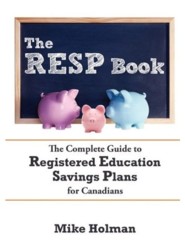Apparently most investors are using their TFSAs for safe instruments such as GICs and high interest savings account, even though they are eligible for equities, such as stocks and bonds. I’ve seen a couple of instances where the name “Tax Free Savings Account” was blamed because it contains the word “savings” which apparently is confusing. Gordon Pape brought it up in his article and Jonathan Chevreau wrote a whole post on the theory.
For some background, here is my post on TFSA rules.
The name has nothing to do with it – think about this – RRSP is a very successful account used by many Canadians. What does the “S” in RRSP stand for? Wait for it….yes, “Savings”!
How is that Canadians are comfortable putting equities in their RRSavingsPs, and yet they are so confused by the TFSavingsA, they are stuck investing in GICs and high interest savings accounts?
People who think that you can only buy GICs in TFSAs are the same people who think you can only buy GICs for the RRSP or worse – they think you “buy an RRSP”. That issue is just plain investor ignorance. No name change can combat that sort of thing.
Here are my reasons why investors like having GICs and high interest savings accounts in their TFSA
Advertising
The banks advertise more. ING in particular, easily smoked every single other financial institution out there with its marketing and implementation when the TFSA came out. People associate banks with GICs and high interest savings accounts, which is one of the reasons for a lot of investors playing it safe.
Simple marketing
If you are trying to attract customers to sign up for a new type of investment account, the last thing you want to be doing is confusing them. The TFSA has a set of new rules to be learned, adding more investing options like stocks and mutual funds doesn’t make for good advertising.
Good implementation by the banks
ING was the first institution to offer a “pre-TFSA” account in the fall of 2008, so you could make your contribution early. They didn’t really put the money in a TFSA account, but rather a non-registered account. The interest in a non-registered account is taxable so they doubled the interest payment to cover the taxes, in effect creating their own temporary synthetic TFSA account. On January 1, 2009 they transferred the money to a TFSA account and everyone was happy. They have continued to offer this “bonus” every fall. Obviously they spent a ton of dough on advertising, but it seems to have paid off.
What were other companies doing? Not much – I recall Scotia allowing people to set up their accounts early, but I don’t know about the other banks. What about the discount brokerages and mutual fund companies? They did nothing, while ING and the banks got all the TFSA money.
I’m not trying to play the blame game here – it really doesn’t matter to me which companies have more TFSA assets. However, the point is to show why most people set up TFSAs with their bank and invest conservatively. It’s not because they are stupid or are poor investors – it’s because the TFSA was a new investment account and the banks (especially ING) were the only visible option at the time.
Small account size
TFSA contribution room was only $5,000 per person in 2009. In the grand scheme of things – this ain’t much. GICs are easy – some of this money will get converted to mutual funds and stocks/ETFs over time.
Emergency fund
I can’t speak for anyone else, but my wife and I decided to start an emergency fund. This has to contain liquid investments which means a high interest savings account. The interest on this money, while puny, is considered taxable income. Putting this money in a TFSA is the smartest choice for us.
Tax sheltering makes sense
You can talk about different tax strategies until the cows come home, but the fact is that if you are going to own investments which produce interest income – putting them into a tax-sheltered account makes the most sense.
Short term investment horizon
The TFSA is far more suited to short-term investments than the RRSP. Someone who is saving for a house downpayment, a new car, a vacation, a house renovation will have a fairly short time line for that money and needs to keep it safe. Hello GIC!
Fees
A lot of discount brokerages charge a lot of money for trading stocks and ETFs – it’s just not worth it for a smaller account.
What will happen in the future?
Going forward, I think the amount of TFSA assets invested in equities will increase as investors have more contribution room to play with. The TFSA account is still pretty new – as more investors learn the rules, more will open accounts that can invest in mutual funds or stocks and ETFs.
If you are thinking about moving your TFSA from one company to another – check out my TFSA December strategy to save transfer fees.
What do you think? Any particular way the TFSA should be used or is any method ok?
